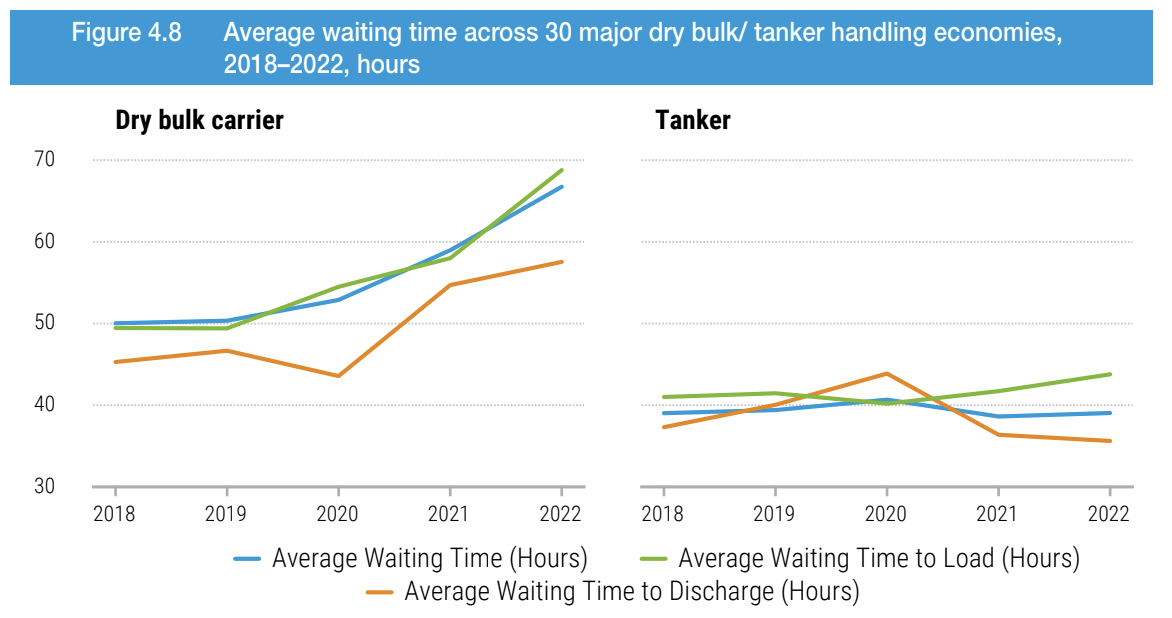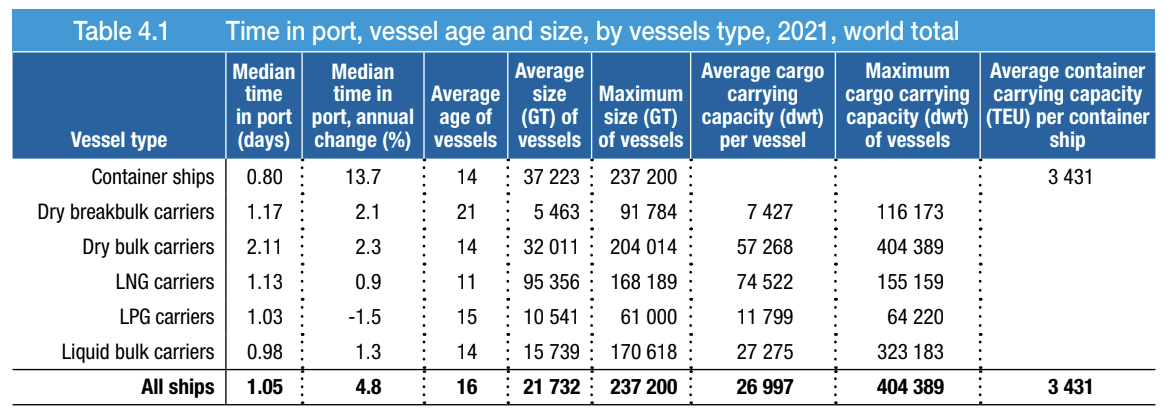In recent years, we’ve seen a dramatic surge in port congestion that’s been disrupting global supply chains. Coupled with an underinvestment in port infrastructure, this has created a perfect storm that is wreaking havoc on logistics efficiency, and one of the major manifestations of this crisis are the rising demurrage costs.
The effect of recent supply chain disruptions can be seen in rising total time spent during port calls and average waiting times across all types of shipments, something we can clearly see in the latest UNCTAD Review of Maritime Transport report:
These supply chain disruptions have increased the relevance of demurrage among carriers, and the rising costs of delays call for improved operations and deep data analysis.
Each year more than 50,000 merchant vessels conduct load and discharge operations around the globe. It is estimated that over the course of a year, 120 million events are manually logged by captains, agents, terminals, and surveyors. The time required by highly skilled professionals to capture every individual event would make the operation simply unfeasible; therefore, demurrage specialists focus on capturing data from SOFs that will be relevant to estimate laytime and verify the claims received from the carriers.
This issue is particularly severe in the bulk shipping industry, where demurrage costs can potentially exceed 20% of the total freight cost for a voyage. In the end, this inefficiency eventually gets passed on to the customers, creating a situation where no one wins.
At Voyager Portal, we view demurrage as an opportunity for businesses to alleviate port congestion, improve contract weaknesses, and drive overall business improvement. Here are some of the best practices we recommend to leverage the most out of your demurrage situations and help you reduce cost and risk.
1. Estimating Demurrage Immediately after Loading
Many businesses make the mistake of calculating laytime and estimating demurrage claims only after they receive a claim from the shipowner. The problem is that this approach leaves no room for adjustments as it becomes purely an administrative task. That’s why we advocate for a proactive stance.
By estimating and analyzing demurrage immediately after the first load port, you gain a real-time assessment of your demurrage risk at every step of the way. Taking into account historical factors like waiting times, congestion, and lineups allows operators to get a realistic estimate of demurrage risk for the entire voyage.
This real-time insight is invaluable for traders as it allows for allocating these costs to the profit and loss statements accurately and anticipating the receiving of a claim. As an operator, it offers dynamic opportunities for risk mitigation by coordinating with terminals and other vessels to expedite discharge and avoid unnecessary delays. Simply put, if you’re a charterer that’s only calculating demurrage once you receive a claim from a carrier, you may be leaving money on the table.
2. Digitize All of your SoF Events Data
One of the most efficient best practices for reducing demurrage costs is to digitize their Statement of Fact (SOF) data. These documents, which may often come as PDFs, provide granular insight into every single event throughout the loading and discharging process, and are invaluable in assessing the efficiency of the terminal, the berth, and the ship discharge itself.
By automating the processing of this data, you not only streamline your demurrage calculations but also equip your sales, marketing, trading, and operations teams with real-time insights. This can inform decisions related to seasonality, congestion, and efficiency, helping you and your customers to make informed decisions about where to conduct business, who to collaborate with, and how to price associated risks effectively.
Besides, digitizing your SoF’s can increase the efficiency of your team and operation as a whole, as we’ve seen demurrage teams up to 3 hours of processing time along the value chain for only one statement of facts document.
3. Connect Charter Party Agreements to Demurrage Logic
Our final recommendation is to analyze your charter party agreement in relation to demurrage, which involves more than just transferring data fields into a database. It’s important to assign logic to your contracts and fields, allowing you to understand how specific clauses in your contract are impacting your demurrage claims.
For instance, are there particular clauses that incur more cost at a certain berth or port? Without integrating this logic, it’s challenging to identify these cost influencers. A logical analysis of your charter party enables dynamic optimization of contracts across the company, allowing for customization down to a specific trade, cargo, or voyage type.
This approach not only highlights areas of potential savings but also empowers you to make data-driven decisions that could significantly improve your bottom line P&L.
The Demurrage Opportunity
Demurrage doesn’t have to be a substantial burden on your company’s resources. By implementing these three best practices—processing demurrage claims in real-time, automating your Statement of Fact data processing, and logically analyzing your charter party—you can significantly reduce the cost of demurrage and streamline your operations.
These changes will give your company the necessary tools to stay ahead making informed, data-driven decisions that result in savings and greater efficiency. Remember: when it comes to demurrage, proactive management and intelligent data utilization are the keys to unlock significant business improvement.
Ultimately, automating document processing and laytime calculations can free up valuable time for demurrage teams, with up to 50% of time savings. The time freed up can be used by analysts to go back to contracts and review clauses to identify other savings opportunities.
They can also be better connected with Port Operations teams to understand certain unusual events in more detail and identify whether those could be deducted from laytime calculations. Moreover, data used and its analysis can lead to new contract negotiations that can sum up to significant savings on Demurrage.



